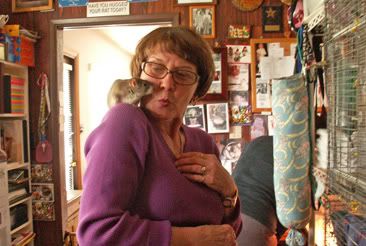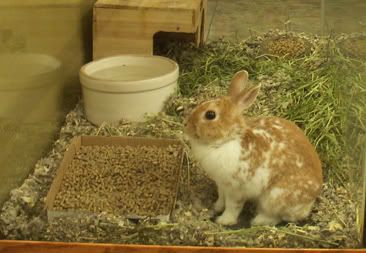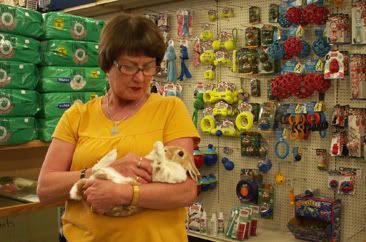
What would Easter season be at the Pet Post without a diatribe from the two of us about buying live rabbits as Easter gifts? The idea of taking home a cute li’l bunny and then dumping him or her in nearby parks or on the college campus makes us madder than March hares.
“The answer is no,” firmly stated rodent rescuer Judy Griffith, when we asked her opinion of bringing in Uncle Wiggily at Eastertide. “What happens is, the parents let their children nag them for a cute little teeny-tiny bunny that they think will be absolutely wonderful. The little bunny grows up, the kids go to school, they have friends, and that’s when the little bunny gets dumped.”
Like the forgotten stuffed toy in The Velveteen Rabbit, Griffith said that unwanted rabbits are abandoned at the park, the El Dorado Nature Center, Cypress College and City College (along with guinea pigs), and at Animal Care Services (ACS), where, Griffith said, half of the 500 brought in each year will be euthanized. In the relative wild, as Miles Nevin said in an excellent lbpost.com article, the bunnies get beaten up and sometimes killed by the wild rabbits. “It’s their turf,” Griffith said.
Furthermore, people who dump bunnies rarely trouble themselves to get them fixed. Easter falls in the spring, and rabbits became associated with the holy day because they’re symbols of fertility, and of course, you know what that means. Rabbits, Griffith said, can breed as early as 4 months old and can have a range of eight to 12 babies. Here come Peter Cottontail and all his brothers and sisters, hopping right into your yard, lunching at the organic garden salad bar and chewing the heads off the tulips. And humans who own the yards often act like Farmer MacGregor, or worse.
“[The former owners] don’t realize that these cute little animals that they’ve taken care of and are used to eating certain foods, and then they go and dump them,” Griffith said. “That’s just death.”
Griffith is the official Rabbit Whisperer, as she puts it, at ACS, but rats were her first love. You could play “Where’s Willard?” at her house, which is a veritable rat’s nest (and we mean that in a good way). Five of the cute little guys, including a Norwegian brown Einstein-faced character named Wild Henry, live in what can be thought of as the Rat-isson, with its comfy luxury squeaker suites. Griffith has ingeniously concealed rescue rats from her amazingly tolerant husband until she’s found them homes, and once had all her toenail polish nibbled off when she accidentally fell asleep on the floor, exhausted, and the rats decided to play Snooze, You Lose with her pedicure.

Griffith tries to adopt out as many rabbits and rats as she can find good homes for. She’s talked people out of dumping rabbits at the shelter and instead taking them to rescues she recommends. She has a heart of the softest gold and reminds you of your favorite librarian or elementary school teacher, until she comes out with one of her stories about abuse or neglect—and she has dozens—and the expletives let fly. Some of the stories would curl your tail: a man who wanted to dump the rabbits he’d gotten as babies two years ago for his children because they were “pains in the butt,” baby rats that she rescued literally from the mouths of snakes, 15 baby mice who had been victims of a sexual perversion called crushing (Google it if you really want a description—she saved them all, by the way). Other stories simply illustrate idiot behavior.
“Someone brought in a rabbit that was dyed pink and blue and green,” Griffith said. “I said, what is this s***?”
Judy Griffith took her first step as a rabid defender of rabbits and rats about 20 years ago when she got one for her daughter. His name was Nibbles, and he became especially attached to her husband.
“They’d rub noses all the time,” she said. “My husband cried when we had to put him to sleep. By that time, Nibbles was worth $1,500 in vet bills.”
At around this time, Griffith’s old dog died and she eventually went to the former animal control facility on Willow Street to adopt another. Animal control was involved in pet therapy in those days, and Griffith’s daughter needed 20 hours of community service for her graduation requirement, so both women became involved. Griffith spent 16 years in charge of pet therapy and spent enough time with the shelter animals to notice that the dogs and the cats were getting much of the attention, but there was no one there for the rabbits. She took that over as well, checking for mites in their long ears, manicuring their toenails, loving them. When rats and other rodents entered the facility, she cared for them, too, spending mostly her own money on their care. The rescues she’s taken into her own home, whether they got past her husband or not, gave her some funny stories to offset the bad ones.
“We had 10 wild rats with their eyes shut that we were nursing to health so that we could release them back to nature,” she said. “We fed them for five days and wiped their asses. One of them jumped off my shoulder and ran through a gap in the door. We set up five humane traps. A week later, my husband says, I’ve got oil on my TV control. I said, I know where that came from.”
It wasn’t oil, of course, but rat pee. Griffith got a neighbor from across the street and the two of them chased the rat around the house for two hours—to the top of a washing machine, behind the refrigerator, through another gap in the door, and under the bed, where Griffith had found that he’d dragged some of her stuffed animals. Finally, they trapped him in the bathroom and grabbed him. See how they run.
Back to the bunnies: The caveat on the ACS rabbit-care webpage states, “Rabbits may be easy to love, but they’re not quite as easy to care for.” The consideration, as with all pets, is finding a good human companion and match him or her to the rabbit, no matter what time of the year you rescue them (yes, we stress rescue—don’t patronize the pet shops). Rabbits come in all sizes and colors, from the tiny Britannia petite to the various giants, but they all need care and adventure—they weren’t meant to sit in cages all day. Griffith gives the following pointers for bunny care:
• First, be sure you’re not allergic to rabbits. Allergies are one reason that rabbits and other animals are abandoned.
• After you adopt your rabbit, spay or neuter him or her immediately. Neutering will keep the male from spraying and will also help him live longer by lowering the possibilities of tumors. Spaying the female will prevent not only litters but also uterine cancer, and she, too, will live longer.
• Rabbits have delicate stomachs and need a special diet. They do well on dark-green vegetables; a little chopped up carrot, apple or banana; lots of timothy hay and alfalfa; and commercial pellets (follow the feeding instructions). Head lettuce has no nutrients, and too much fruit will give them diarrhea. Don’t feed them bread or cereal.
• Rabbits love to gnaw and need to do so because their teeth grow. Provide hardwood blocks with no splinters or commercial products from the pet supply store. In fact, their teeth, as well as their nails, need periodic trimming (gleeah!). For this and all medical procedures, take them to a vet who has experience in treating rabbits and other rodents. Look on the Web for exotic animal hospitals; Griffith uses Long Beach Animal Hospital on E. Anaheim Street.
• Bunnies are easily litter-box trained. Griffith gave one of hers freedom to find out where he liked to poop first (and the pellets are so, so easy to pick up), and then put a domed box in the spot. The rabbit never missed once.
• If your rabbit is kept outdoors, be sure that his hutch or cage is protected from predators, which can be a challenge. Furthermore, rabbits are excellent tunnelers; if there isn’t a high brick or stone wall or a similar protection, he or she won’t be safe in the yard. Make sure the hutch or cage is also up high and out of the sun (rabbits are sensitive to heat). Don’t put the rabbit in the garage.
• Rabbits are only smelly and dirty if their cages are smelly and dirty. Clean them out.
• Although rabbits, and rats as well, can enjoy some freedom around the house, a cage or hutch is where they’d spend unsupervised time and sleep. Griffith’s rat pads are equipped with hammocks, shelves, carpeted floors and amusements. Rabbits need larger townhouses and hutches, and the floors should be lined with carpet to avoid bumble foot, which is a bacterial inflammation that affects the underfeet of pet rodents and some birds. Bunnies may start out small, she says, but many will grow larger and will not do well in a cramped space. Be sure to get a cage large enough for your long-eared friend to move around in comfortably.
• Cage bottoms should be comfy for paws, but be careful of what you line them with. Cedar and pine can be deadly for rabbits if they chew on it—and they will—and could also give them mites. One of Griffith’s grim bunny tales involved a pet rabbit who had passed away and whose guardian donated his cage to Griffith. When cleaning out the cage, she found the bottom squirming and crawling with mites, which had, unbeknownst to the rabbit’s former caregiver, caused his death. One product that Griffith recommends is Care Fresh, made from recycled paper and available at many pet supply stores.
• Make sure that you rabbit-proof any room in which your pet is going to frolic. Rabbits can have some freedom in the house, but they like to chew on things—that includes electric and cable cords. If this happens, the best thing you can expect is that you won’t be able to watch TV. The worst, we don’t want to think about.
And never, ever pick them up by the ears.


This is Snuggles, an affectionate little dwarf bunny who was found running around loose in the city. She’s waiting for a responsible and loving home at Paw Shoppe Pet Center, 6416 E. Spring St. in Long Beach, (562) 425-5131.
For rabbit adoption, visit The Bunny Bunch or call (909) 626-3946.
To adopt a rat, contact Judy Griffith at [email protected].
Chickens and ducklings? Adopt one virtually from Animal Acres by clicking here.
Best Friends has a similar idea: Sponsor a bunny for Easter. Part of the gift will help the Best Friends Bunny House. Visit this website for de-cotton-tails.
Random Clawings
In case you missed it, visit this website for a concise, wise Press-Telegram commentary about suburban wildlife by author Sandie Freeman.
Events
April 14, ACS Pet Literacy Launch
April is Long Beach Poetry Month, so bring your Charles Barkowski and Edna St. Vincent Maltese and engage a pet! Animal Care Services (ACS) is launching a program to enrich the “village” atmosphere of the facility’s environment and at the same time increase the adoptability of the animals. Volunteers are encouraged to come and—read to the animals, which will improve their sociability (and vocabularies, no doubt)! 3–4 p.m. at Pitchford Companion Animal Village, 7700 E. Spring St. in Long Beach, (562) 570-PETS. RSVP to [email protected].
Ongoing Pet Food Drive at Neighborhood Resource Center
The Neighborhood Resource Center in tandem with Food Finders is collecting both pet and people food for needy families. Bring what you can to the NRC office at 425 Atlantic Ave., (562) 570-1010.
April 11, Bunny Bash at Wiskers
Pet Photo Pros and Wiskers are sponsoring an Easter celebration featuring goodies and a Best-Dressed for Easter photo contest, with your dog, of course (or whatever little beastie has the patience to dress up in Easter Sunday best). Judges include Justin Rudd of Community Action Team and countless other events; Debra Van Duren, owner of Mood Swings Jewelry; and Bonnie Sheehan, the Hearts for Hounds Angel. The event runs between 11 a.m.–4 p.m. Call (310) 294-0197 or visit Wiskers at 4818 E. 2nd St., Long Beach for info.
April 16, Friends of Long Beach Animals ‘Benefit for the Animals, Long Beach Playhouse
Join Friends of Long Beach Animals (FOLBA) for a delightful April evening at the Long Beach Playhouse and help get out the word about spay/neuter and humane education at the same time. Enjoy a 7:30 performance of Sabrina Fair, a romantic love-triangle comedy set in the bon-vivant atmosphere of 1950s Long Island, New York. The event also includes a reception at 6:30, with an hors d’oeuvres spread and chocolate goodies of all sorts (including pretzels) for intermission dessert; a reception bar; piano entertainment by Ralph Brunson; and door prizes, including FOLBA’s famous Dine-out Package, with a value of $369. Dr. Loren Eslinger, the veterinarian for Long Beach Animal Care Services, will be honored as the 2009 Hero to Animals. Tickets $25 on a donation basis; available at the following locations:
• Belmont Pets and LaunderPet, 3429 E. Broadway, (562) 433-3605
• Bixby Knolls LaunderPet, 4102 Orange Ave. # 113, (562) 427-2551
• Go Dogs Go, 3440 N. Los Coyotes Diagonal, (562) 421-9797
• Seal Beach LaunderPet, 318 Main St., Seal Beach, (562) 430-7196
• Wiskers, 4818 E. 2nd St., (562) 433-0707
• CosmoPAWlitan Boutique, 4107 Viking Way Long Beach, (562) 354-6040
Or call FOLBA at (562) 988-SNIP (7647)
Email: [email protected]
The Playhouse is located at 5021. E. Anaheim St. in Long Beach.
Come and get your veg on! The event is FREE and open to ALL. Sign up to PARTICIPATE in the VEGGIE PRIDE PARADE, make a DONATION to become a parade sponsor, VOLUNTEER for the event, or ALL of the above! Call 661-269-5404 or visit veggiepridela.com for more information and to register for the VEGGIE PRIDE PARADE LA today.
April 26, L.A.’s First Veggie Pride Parade
Come and get your veg on! This free event begins at 11 a.m. and is dedicated to the vegetarian lifestyle and ending animal exploitation. Entertainment, rallies and great food from the area’s best vegetarian restaurants. Location: Culver Events, 11948 W. Washington Blvd., Los Angeles. Visit this website for more information and registration.
